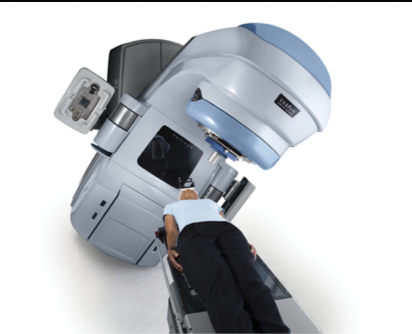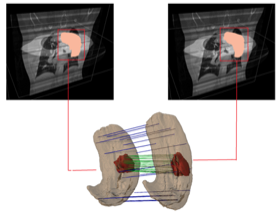using Geometric information analysis and processing.
Contact: Xin Li, Assistant Professor
LSU Department of Electrical & Computer Engineering
LSU Center for Computation & Technology
http://www.ece.lsu.edu/xinli
Li's research group is currently developing a computational framework to model the respiratory motion of the tumor and surrounding organs, which could guide the automatic offline planning and intelligent online management of lung radiotherapy.
Computational Medicine Application
Modeling Respiratory Motion of Lung Tumor
- Most solid tumors should receive radiation treatment: the radiation beam should hit the tumor without damaging nearby organs and tissues
- Tumors could be moving and deforming during respiratory cycles, it is desirable to model their trajectories and deformations accurately
Our goal: a computational framework to model the movement and deformation of the tumor and surrounding structures- The temporal lung data are reconstructed from 3D CT and MRI scans
- Offline preprocessing stage: we process the scanned sequential medical images, and build a 4D parametric lung deformation model that approximates the respiratory cycles
- Online radiology treatment: the parametric model is used to predict the position and shape of the tumor; this will guide the shape and targeting direction of the radiation beam
Our Computational Framework
Offline Modeling and Planning
- Extract and reconstruct the geometric model from 3D CT scanning
- Compute volumetric mapping to match 3D volumes; interpolate the mapped temporal data to construct the deforming 4D (spatial + temporal) model
- Refining the 4D model (constructed from spatially dense but temporally sparse CT images) using the (spatially sparse but temporally dense) MRI images
[Iyengar, Li, Sawant et al. “Toward More Precise Radiotherapy Treatment of Lung Tumors,” IEEE Computer, Vol. 45, Issue 1, pp. 59-65, 2012]
Online Prediction and Delivery
- Synchronize (match) the 4D model with the online X-ray image taken when the patient is on the table
- Optimize the shape, position and targeting direction of the radiation beam
Li received the IBM faculty award (2011) for the maximum award amount of $40,000 for this project. The IBM Faculty Award is a highly competitive international program that intends to foster collaboration between researchers at leading universities worldwide and those in IBM research, development, and service organizations, and to promote courseware and curriculum innovation to stimulate growth in disciplines and geographies that are strategic to IBM.





